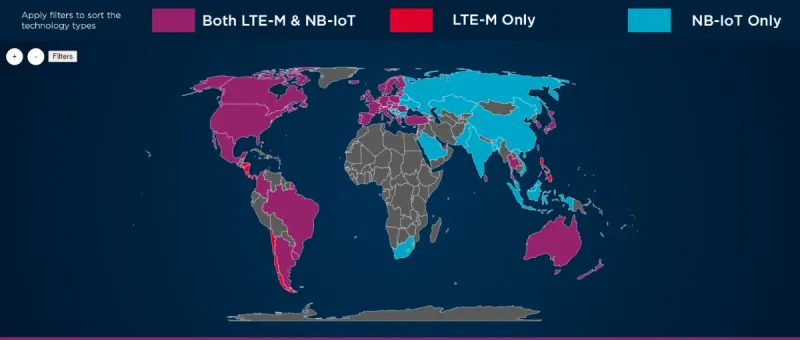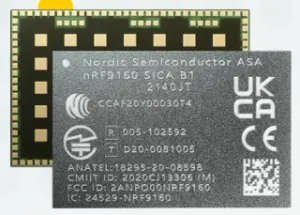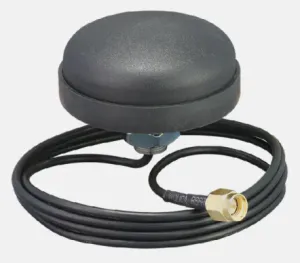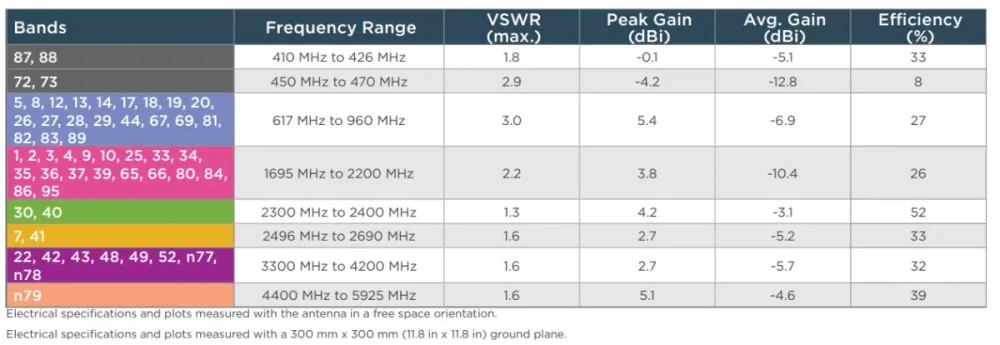Cellular Communication Protocols
LPWAN (Low Power Wide Area Network) is a term used to describe a group of cellular communication protocols designed to support IoT devices. This includes the LTE Cat-M1 and NB-IoT standards. The general idea is that these protocols support low power, low bandwidth, low cost communication between cell sites and many simple low power (e.g. battery, solar) embedded devices such as MCUs and their cellular modems.
Applications for LPWAN include:
- Smart water/gas/electricity meters
- Environmental monitoring (e.g. water quality, air quality, temperature)
- Smart cities (e.g. smart bins, street lights, parking and metering)
- Asset tracking (e.g. cars, trucks, trailers, shipping containers)
- Industrial IoT (e.g. machinery, equipment)
- Agricultural IoT (e.g. livestock, soil, weather)
LTE (Long Term Evolution) is a term used to describe the fourth generation (4G) cellular networks designed to replace 3G. LTE Cat-M1 and NB-IoT are two variants of LTE designed for IoT devices. Even though they were introduces as part of 4G, both LTE Cat-M and NB-IoT will continue to evolve with newer 5G standards.
This is a placeholder for the reference: lpwan-standards-comparison compares some of the key metrics across many of the popular LPWAN standards.
| Standard | Device receive bandwidth | Peak downlink data rate | Peak uplink data rate | Latency | Transmit Power |
|---|---|---|---|---|---|
| LTE Cat M1 | 1.4 MHz | 1 Mbps | 1 Mbps | 10-15 ms | 20, 23 dBm |
| LTE Cat M2 | 5 MHz | 4 Mbps | 7 Mbps | 10-15 ms | 20, 23 dBm |
| LTE Cat NB1 | 180 kHz | 26 kbps | 62 kbps | 1.6-10 s | 20, 23 dBm |
| LTE Cat NB2 | 180 kHz | 127 kbps | 159 kbps | 1.6-10 s | 14, 20, 23 dBm |
LTE Cat-M1
LTE Cat-M1 is a cellular communication protocol designed for IoT devices. It is based on the LTE standards and supported by many cellular providers around the world. It competes with the NB-IoT standard. It has two main factors which makes it ideal for IoT devices:
- Low power consumption: Cat-M1 supports a power saving mode which allows devices to sleep for extended periods of time, reducing power consumption compared to regular LTE communication.
- Narrow bandwidth: Cat-M1 uses a bandwidth of 1.4 MHz. This is narrow compared to other LTE variants, which allows for more devices to be connected to a cell site on the same frequency band, supporting densely deployed IoT devices.
LTE uses categories to classify the capabilities of devices, where Cat 1 devices support download speeds of 10 Mbps and Cat 4 150 Mbps. Cat M1 supports up to 1 Mbps.
Cat-M1 uses a bandwidth of 1.4 MHz. This is narrow compared to other LTE variants, which allows for more devices to be connected to a cell site on the same frequency band. A typical LTE cell site can support 10x as many Cat-M1 devices compared to regular LTE devices2. This makes it ideal from the cellular providers perspective for IoT devices that are densely deployed.
Coverage
Cat-M1 is not at widely deployed as regular LTE. However, as of 2024 it has good coverage in many countries. This is a placeholder for the reference: gsma-mobile-iot-deployment-map shows the coverage of LTE-M and NB-IoT across the globe.
Power Consumption
Cat M1 reduces the power consumption of devices with two features regular LTE does not support:
- Power saving mode (PSM)
- Extended Discontinuous Reception (eDRX)
Cat-M1 has a power saving mode (PSM) that allows the devices to sleep for extended periods of time, reducing power consumption. Devices can negotiate an extended sleep period (hours or days) with the network. If any traffic arrives for the device while it is in sleep mode, the network buffers the data until the device wakes up (becomes ACTIVE)2.
eDRX (Extended Discontinuous Reception) also allows for further power savings for IoT devices. Phones don’t normally have a continuous connection with the cell site. Instead, they frequently connect and check for new data every 2.56 seconds (typically). Between these connections, the devices cellular modem is in a low-power sleep state.
eDRX allow for the device to negotiate longer sleep periods with the network. They can negotiate two parameters:
- PTW (amount of time the device is reachable for in each cycle) between 1.28 and 20.48 s
- eDRX cycle (amount of time the device is unreachable for in each cycle) up to 48 mins
The Paging Time Window (PTW) is the amount of time the device is reachable for in each cycle. The eDRX cycle is the amount of time the device is unreachable for in each cycle. Together they sum to form the Page Cycle Length (PCL).
Bands
Cat-M1 is designed to operate in the frequency bands specified in section 5.5E in 3GPP TS 36.101, which include4:
- FDD (half duplex and full-duplex) bands - 1, 2, 3, 4, 5, 7, 8, 11, 12, 13, 14, 18, 19, 20, 21, 24, 25, 26, 27, 28, 31, 66, 71, 72, 73, 74, 85, 87 and 88
- TDD bands - 39, 40, 41, 42 and 43
Modem Support
The Nordic nRF9160 SiP (System in Package) supports Cat-M1 (as well as NB-IoT). It has a quoted current consumption of eDRX @ 81.92s: 18 µA in Cat-M1, 37 µA in Cat-NB1 (UICC included5.
NB-IoT
NB-IoT (Narrowband Internet of Things) is a cellular communication protocol designed for IoT devices. It is also known as LTE Cat NB1 or LTE Cat NB2 (different standards). It competes with the LTE Cat-M1 standard.
Unlike Cat-M1, NB-IoT does not support cellular tower handovers. This means that devices using this network must largely remain stationary7 8.
There are two NB-IoT standards9:
- LTE Cat NB1: Standardized in 3GPP Release 13.
- LTE Cat NB2: Standardized in 3GPP Release 14. LTE Cat NB2 is a newer standard which improves on LTE Cat NB1, increasing the data rates, adding support for lower transmit powers and adding positioning support.
This is a placeholder for the reference: lte-cat-nb-comparison compares some of the key metrics of the two NB-IoT standards.
| Feature | LTE Cat NB1 | LTE Cat NB2 |
|---|---|---|
| Bandwidth | 180kHz | 180kHz |
| Max. downlink data rate | 26 kbps | 80/127 kbps (1HARQ/2HARQ) |
| Max. uplink data rate | 62 kbps | 105/159 kbps (1HARQ/2HARQ) |
| Positioning | Cell ID | OTDOA, E-CID |
| Max. transmission power | 20, 23 dBm | 14, 20, 23 dBm |
The addition of the lower 14 dBm transmit power in Cat NB2 allows for devices with smaller batteries and thus smaller overall form factors to use the network.
Antennas
Wide band cellular antennas are designed to work with the wide range of frequencies used by cellular networks. A common range supported is from about 600-800MHz up to 5G (5GHz).
Examples
Linx Technologies ANT-5GW-SPS1 Series
The Linx Technologies ANT-5GW-SPS1 Series is an external panel mount puck-style multiband antenna. It supports:10
- 5G
- LTE
- LTE-M
- NB-IoT
- 433 MHz, 868 MHz, and 915 MHz LPWA
It is a ground-plane independent dipole antenna so it can be mounted on metallic and non-metallic surfaces.
This is a placeholder for the reference: fig-linx-technologies-ant-5gw-sps1-series-band-specs shows the band (frequency) specifications for the Linx Technologies ANT-5GW-SPS1 Series antenna.
Footnotes
-
Wikipedia (2024, Apr 1). Narrowband IoT. Retrieved 2024-10-02, from https://en.wikipedia.org/wiki/Narrowband_IoT. ↩
-
Vijay Devarapalli (2021, May 5). When to Use LTE Cat M for IoT Devices. Twilio. Retrieved 2024-10-01, from https://www.twilio.com/en-us/blog/when-to-use-lte-cat-m. ↩ ↩2
-
GSMA. Mobile IoT Deployment Map. Retrieved 2024-10-01, from https://www.gsma.com/solutions-and-impact/technologies/internet-of-things/deployment-map/. ↩
-
Eseye. Frequency bands. Retrieved 2024-10-02, from https://docs.eseye.com/Content/GettingStarted/FrequencyBands.htm. ↩
-
Nordic Semiconductor. nRF9160 Product Specification. Retrieved 2024-10-02, from https://docs.nordicsemi.com/bundle/ps_nrf9160/page/nRF9160_html5_keyfeatures.html. ↩
-
Nordic Semiconductor. Products > nRF9160 [product page]. Retrieved 2024-10-02, from https://www.nordicsemi.com/Products/nRF9160. ↩
-
Darek Fanton (2021, Mar 18). Cat M1 Wireless: What is it, what’s it for, and why would you use it?. OnLogic. Retrieved 2024-10-02, from https://www.onlogic.com/blog/cat-m1-wireless-what-is-it-whats-it-for-and-why-would-you-use-it/. ↩
-
Michael Bosson (2023, Mar 3). LTE explainer: LTE Cat 1, LTE Cat 1bis, LTE-M, and NB-IoT. Onomondo. Retrieved 2024-10-02, from https://onomondo.com/blog/lte-standards-for-iot-comparison/. ↩
-
Haltian (2019, Jan 30). NB1 vs. NB2 complete comparison table and overview. Retrieved 2024-10-02, from https://haltian.com/resource/nb1-vs-nb2-complete-comparison-table-and-overview/. ↩
-
Linx Technologies. ANT-5GW-SPS1 SERIES - Panel Mount 5G/LTE Antenna [datasheet]. Retrieved 2025-06-09, from https://www.te.com/commerce/DocumentDelivery/DDEController?Action=srchrtrv&DocNm=ANT-5GW-SPS1_SERIES&DocType=Data+Sheet&DocLang=English&DocFormat=pdf&PartCntxt=ANT-5GW-SPS1-1. ↩ ↩2 ↩3





